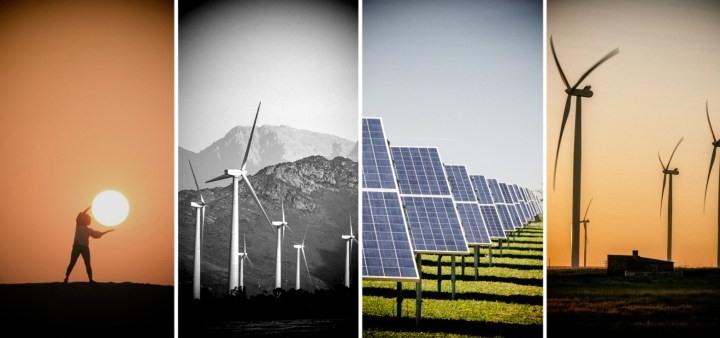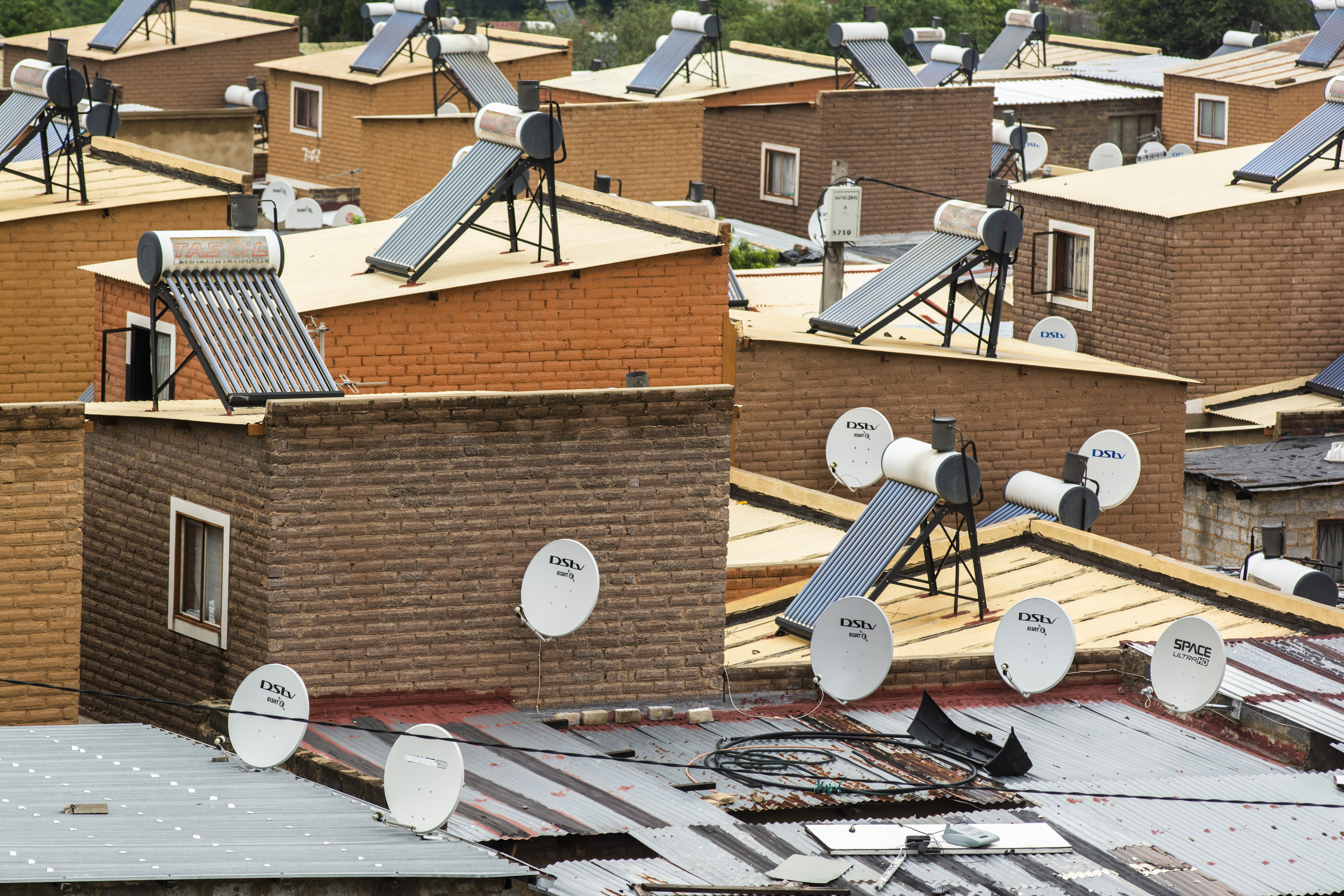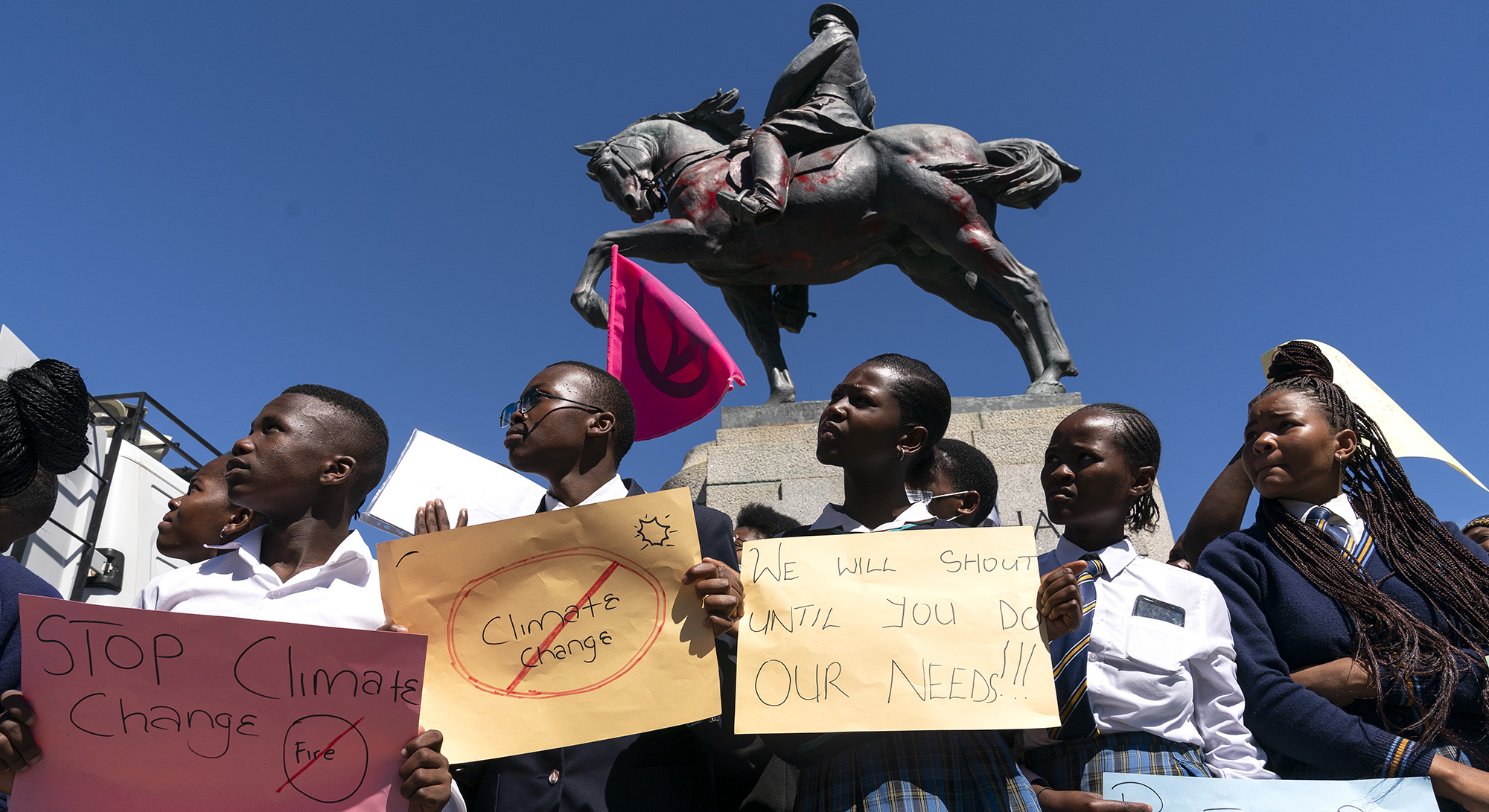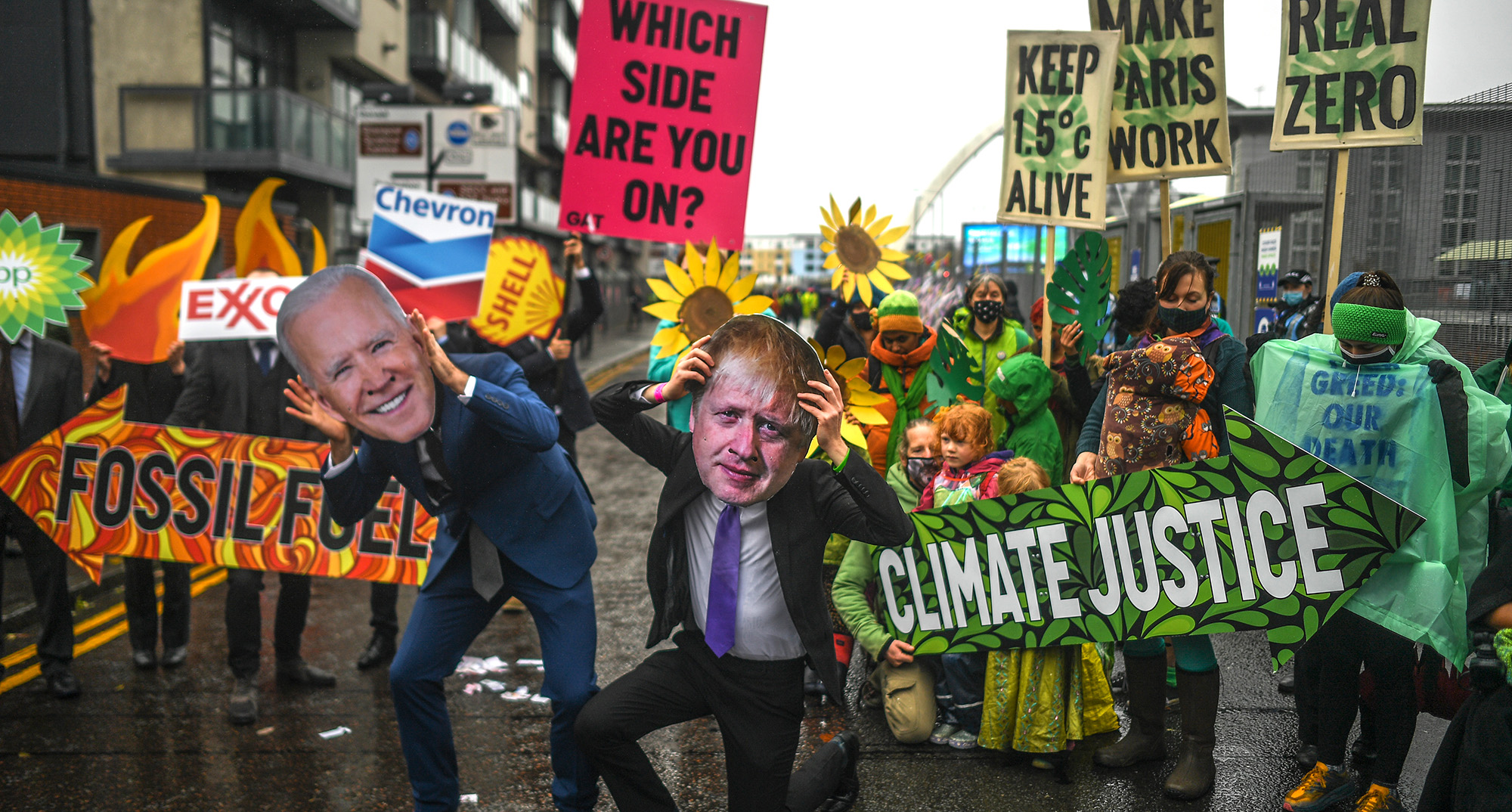BETWEEN THE LINES OP-ED
We need more diverse information if climate change is to be tackled effectively

Readers need information from professional journalists that regularly include — or at least question — understandings different from the mainstream ones.
The admirable diversity among Daily Maverick readers makes it unsurprising that, as I suspect, many readers like me will be disappointed by the narrow range of opinions Daily Maverick journalists contact on such controversial issues as climate change.
“System change, not climate change” is a growing global call, yet its many proponents don’t seem to be approached for comment. This omission is standard across South African news platforms — Daily Maverick, however, is special because it goes beyond “standard” journalism. The call being made in this article is to Daily Maverick, rather than any of its individual journalists.
A comprehensive rejoinder to the comments made by the climate change/energy specialists quoted in recent Daily Maverick articles is not practicable here. I shall, accordingly, address only three issues raised by them.
- How to sell your excess solar power
The household selling of solar power was widely seen as being a “key” aspect of the finance minister’s recent Budget. The government, desperate to reduce the burden of rolling blackouts, especially in an election year, welcomes this approval of its new policy which both reduces electricity demand while increasing energy supply. (While the finance minister has not renewed the very limited rooftop incentive because it is unaffordable to the government, as the EV White Paper acknowledges, the City of Cape Town offers “R15-million up for grabs” over the next six months.)
Thus, what was once called small-scale embedded generation (Sseg) that restricted the generation to 10MW, is no more. This threshold, increased to 100MW in 2021, has subsequently been removed. Solar and wind projects of any size can now be built without a licence.
Indeed, such is the government’s desperation that notwithstanding its “austerity” cuts imposed on all public services, it is happy spending public money with its 125% tax rebate to business-installed embedded generation to attract still more private “energy sellers”.
But that is only the beginning of the public cost and the government’s policy incoherence. What might appear to be a reasonable approach to reducing the highly expensive and disliked rolling blackouts, is egregious short-sightedness.
The omission of any forward-thinking results in such things as a two-tier electricity system that replicates the inequalities of the health system. To those that have (money), shall be given cheap, uninterrupted electricity (almost) without limit. To those who have not, they will have to do with the second-tier electricity provided by what remains of Eskom.

Solar-powered water heaters on rooftops above shacks in the Alexandra township in Johannesburg, South Africa, on Thursday, 12 November, 2020. (Photo: Waldo Swiegers/Bloomberg via Getty Images)
This two-tier system is the very opposite of the just transition, to which the government is supposedly pledged. As Mark Swilling notes:
“As [the previously uniting national grid] breaks up so too does the promise of affordable energy for all. Like the rise of private security, private education and private healthcare in response to inadequate policing, public education and public healthcare, so too are we witnessing the rise of private energy for those who can afford to reduce their dependence on the national publicly owned grid. This is not a recipe for a just transition.”
Eskom’s revenue comes from selling electricity. With its biggest users — both business and private households — being rewarded by the government for abandoning Eskom, how will Eskom generate its revenue? Apart from its running costs, how is it supposed to pay off its enormous debt?
The question is rhetorical for it will have little choice other than to do what it has been doing for over a decade: increase the price of its electricity, with the near 13% hike effective from 1 April being but the most recent.
This means an acceleration of its death spiral: expensive electricity leading to decreased revenue resulting in even more expensive electricity and a further decrease in revenue, and so on.
The price increase means that electricity, already unaffordable to most South Africans, will become even more unaffordable.

Young South Africans take part in the Global Climate Strike outside Parliament in Cape Town on 25 March, 2022. (Photo: EPA-EFE / Nic Bothma)
This means the growth in our already shameful poverty levels and world-beating inequality.
This also means our government exacerbating the bankruptcy of our already dysfunctional municipalities. Government provides only some 23% of municipal revenues, the rest is supposedly self-generated, mainly via the sale of electricity, which at a national rate of 26% is the largest single source of municipal revenue!
Metropolitan municipalities especially rely heavily on revenue from the sale of electricity to its wealthy households, but these are the very households that the government encourages to bypass Eskom by generating their own electricity. The largely unquestioned invite is for even more of these wealthy households to become market-driven sellers of electricity.
Making the market the master of such developments marks a further nonsense of government planning and democratic accountability. It is cynical formalism, for instance, for the government to ask for public comment on its Integrated Resource Plan when the government has effectively handed over much of that decision-making to the vagaries of the market. Finally, electricity, like water, should be recognised as a basic human need. As such, it needs urgent decommodification. It needs a progressive government to provide at least 350 kWh free to all households, rather than the derisory 50 kWh the government currently finances municipalities to supply households. However, not only is this free electricity now restricted only to those households that somehow manage getting registered as “indigent” but only some 20% of those households so stigmatised actually receive any free electricity.
- Electric Vehicles
The general public response to the finance minister’s Budget has been to welcome the electric vehicle (EV measures) in it. Among the many things left unsaid about EVs are the following:
The introduction of EVs, especially in Europe and the US, had little to do with either transport or a green economy. They were introduced mainly as an expected economic stimulus following the Great Recession of 2008.
Presenting EVs as “green”, especially when there was nothing of substance suggesting that governments were taking climate change seriously, allowed governments to use taxes and at least 13 broad incentives to induce manufacturers to produce and people to purchase EVs. Were it not for the perception of saving the planet, would these generous handouts to manufacturers and the rich have been accepted with such silence?
Transport considerations, including the government’s Electric Vehicles White Paper of November 2023, and the green economy have even less to do with the finance minister’s supposed “green” budget for South Africa. Mikel Mabasa, CEO of the National Association of Automobile Manufacturers of South Africa (Naamsa), had good reason to note:
“The global transition towards EVs is a critical step to secure the future of the automotive industry in South Africa. Our rapid adoption to newer technologies is critical for the domestic automotive industry’s long-term success and growth. … If we want to remain globally competitive, we have no option but to play with the big global players who are leading the EV charge.”
Even if it isn’t already too late for South Africa “to play with the big global players”, South Africa is at risk of losing more than 50% of its production value between July 2025 and 2035 due to an almost total European ban on non-EV vehicles. Moreover, 75% of all vehicle production in South Africa is exported to the EU and Britain alone, while the vehicle sector constitutes 17.3% of South Africa’s total manufacturing output and 12.5% of its total export value.
The only recognition of this reality in the finance minister’s “green” Budget is that producers of electric cars — not domestic buyers — can claim 150% of investment spending as of 2026. (This merely adds a little to the enormous public subsidies that keep the car industry profitable. Treasury estimates that government support for the auto industry totals R30-billion a year, three times the Department of Trade, Industry and Competition’s budget. (A “system change” approach would be an integrated public transport system that is both affordable, frequent, reliable and safe and thus be an essential prerequisite to removing a large number of carbon-emitting private cars from our already congested, unmaintained and deadly roads).
EVs in South Africa will remain as negligible as they currently are: fewer than 2,000 EVs and 1,000 Plug-in Hybrid Electric Vehicles (PHEV) respectively by June 2023. This is because of the enduring nature of the three main reasons for their almost invisibility: As the White Paper itself acknowledges, EVs are far too expensive; there are hardly any battery charging points; and, as for their “greenness”, the charging points rely on electricity — when its available — that comes from coal-fired stations.
Nevertheless, the respectability of electric cars does, as intended, obscure the unsuitability of private cars, regardless of their engine types while conveying the message that one day you too will be able to afford a car that doesn’t aggravate climate change.
A reminder that EVs are still cars and that cars, regardless of their engine type, cause (I draw here on a previously mentioned Daily Maverick article of mine, unless otherwise stated):
- The death of approximately 1.19 million people each year, with between 20 and 50 million more people being injured;
- Urban congestion — the lived experience of anyone who has the misfortune of travelling by road in virtually any large city, regardless of how many, or few, EVs there are. The average American already spends more than 12 weeks a year sitting in traffic congestion [Daily Maverick 28/2/2023]. There were about 1.47 billion vehicles worldwide in 2023, which gives scale to the problem. (Vehicle numbers tend to double every 20 years);
- Urban gridlock: gets continually worse because of ever-increasing vehicle volumes. These volumes are integral to the enormous cost of new roads, as well as road maintenance. The US alone spends some $416-billion annually;
- Water use: up-to-date and accurate information is not readily available. The estimates of water used in manufacturing vary from 4,000 litres to 147,631 litres per car. The only certainty is that car manufacturing is a very thirsty business in a very water-scarce world;
- Used tyres remain a major pollutant and health hazard;
- Resource depletion: EVs exacerbate this problem rather than just reproducing it;
- The weight of EV batteries remains a large unrecognised problem. Batteries are considerably heavier than the engines they replace. The head of the US National Transportation Safety Board gave examples when warning about the “increased risk of severe injury and death” posed by EVs’ heavier weights and increasing size, power, and performance. The main warning from the National Transportation Safety Board was against these “unintended consequences” of the dash for EVs; and
- EVs ensure the perpetuation of the blight of human rights abuses.
- ‘Energy transition offers one-in-Century potential for South Africa to reindustrialise’
And so say all of us! This headline from an Engineering News interview with Trade and Industrial Policy Strategies senior economist and South African Renewable Energy Masterplan facilitator Gaylor Montmasson-Clair, was sufficient for a Daily Maverick reporter to include it in her takeaways from the Finance Minister’s ‘green budget’. Particularly impressive for her was Montmasson-Clairs information that:
“During the second quarter of 2023, more than $1.7-billion worth of solar panels, inverters and lithium-ion battery systems were imported into South Africa, and this number excludes other components and parts.”
In addition to solar panels, South Africa should indeed be manufacturing its own lithium-ion batteries and inverters rather than importing them at a combined record cost of $3.8-billion last year, or about R70-billion, which was more than double the $1.7-billion of 2022.
The Alternative Information and Development Centre (where I work) has been urging the development of a local renewable energy sector since 2011. We did this having learnt that the majority of climate jobs were in the manufacture and construction of renewable energy projects, rather than in their subsequent maintenance.
Despite this one-in-a-century opportunity for South African re-industrialisation, the government persists with its hostility to its own once much-praised Renewable Energy Independent Power Producer Programme (REIPPPP).
More importantly, the government persists with its failure to recognise that a transformed Eskom offers the only hope of producing renewable energy on a scale required to develop a new domestic renewable energy sector.
This reality requires brief reminders, such as:
- The Zuma-sanctified and Gupta-manufactured takeover of Eskom to ensure the minimum threat to coal was sufficient for local renewable energy manufacturers to begin the first of the closures of local renewable energy manufacturing. In this case, it involved a German company — SMA Solar Technology — that happened to be one of the world’s biggest solar technology companies. It closed its Cape Town factory due to what it described as “the government’s lack of commitment to green energy”; a position sparked by “shocking statements” about the independent power producer programme, which was effectively shelved by Eskom CEO Brian Molefe. That was in August 2016;
- A year later the then Energy Minister, Mmamoloko Kubayi, kicked bid windows 3.5 and 4 — which had already been in limbo for two years — even further into the future. (Kubayi is a reminder for the many people who think that things were fine until the arrival of Gwede Mantashe.) A Business Day editorial — “Kubayi turns off energy future” — reported her announcement that while the bids would be signed by the end of October 2017, they would not be commissioned until 2021; and
- Worse was to follow. Renewable energy investments in 2017 continued the slump in South Africa, as Eskom continued to refuse to sign power purchase agreements with renewable energy developers without first securing cuts in the contractually agreed electricity prices to be paid. The result was that commitments fell to just $102-million, compared to $844-million in 2016, $3.5-billion in 2015 and the record figure of $5.6-billion in 2012.
Notwithstanding the above and including the government’s ambivalence to REIPPPP, together with its latest iteration of the IRP still imposing caps on renewable energy, the need for a local industry remains unchanged.
But there are now two additional obstacles. First is the national grid that cannot cope with additional renewable energy from the areas most suitable for renewable energy. This longstanding problem has at last been recognised, even though action has hardly moved beyond lots of talk.
Second, such is the global dominance of China in this market that the largest solar module production site in Europe, based in Germany, is due for imminent closure. It announced it could no longer compete with Chinese prices, plus the unspecified trade restrictions imposed by India and the US which had “made full-scale production no longer possible”.
The Chinese dominance makes all the more necessary the essential — though hardly mentioned — need for considerable state support and protection. Without the government’s explicit assurance of such measures, it is guaranteed that private capital for the birth of a meaningful domestic sector will not be forthcoming.
AIDC has long been pointing out that the required support and protection will be contrary to World Trade Organization agreements (WTO) and others to which South Africa is a party. Only the US and, now the EU, are sufficiently powerful to impose unilateral protections — and get away with it. Might remains right.
But having set the precedent, it is now long overdue for South Africa, in concert with many other countries, to challenge these agreements “rigged in favour of the rich”, as our former finance minister Trevor Manual put it so pithily as long ago as 2005.
And to do so collectively. The growing worldwide anger at the UN’s enduring failure to tackle climate change provides global support for developing countries to take the lead and confront the displeasure of the rich countries which have rigged world trade so shamelessly in their favour.
All we have is each other
Well-known activist academic, Naomi Klein, with the brief to rekindle hope, ended one of her recent speeches, saying:
“All we have is each other. All we have is our movements and the power we build together. All we have is our solidarity. Our determination. Our resolve. And our shared moral commitment to the preciousness of life. With that, we can build a [better]world …. With that, we will earn our hope.”
But the “we” she invoked is still far too small to matter. This is where journalists come in. And, yes, I’m thinking of Daily Maverick with its admirable history of climate journalism (as its founders recently informed the Competition Commission) along with a number of other media platforms.
In a Daily Maverick article from January this year — “After 28 years of COPs, it’s time to go beyond just saying ‘blah, blah and blah’ — I appealed to the specialist climate change/environmental journalists to be more questioning of the official “blah and blah” being spread in the build-up to whatever number the forthcoming of these annual, specifically climate change meetings of Heads of State members of the UN might be.

Protesters wearing masks of Boris Johnson and Joe Biden protest outside the entrance to the COP26 site on 12 November, 2021 in Glasgow, United Kingdom. (Photo: Peter Summers/Getty Images)
If they were to do so, we might no longer be so surprised — or dispirited — by the “blah and blah” to emerge from wherever the particular COP might have been held.
This time my appeal is to full-time journalists to go beyond the narrow band of climate change and energy specialists they draw on. Daily Maverick does already do this (for example here) but not nearly with sufficient consistency.
Readers need information from professional journalists that regularly include — or at least question – understandings different from the mainstream ones. This could sometimes mean going beyond just republishing articles exposing the myths of recycling for instance, but never questioning why waste is integral to our economy. A comment from a proponent of system change would thus be helpful.
To (slightly) paraphrase Branko Brkic, Daily Maverick’s Editor-in Chief, “if you don’t know [the options], you don’t know what’s right”.
Moreover, these alternate views are readily available from a range of respectable organisations/institutions. Stellenbosch University’s Centre for Sustainability Transitions; Wits’ Centre for Social Change and Southern Centre for Inequality Studies; 350.org; Centre for Environmental Rights (CER); Green Connection; and African Climate Alliance are among many others (including the AIDC) that come immediately to mind. By including these other sources of information, readers are better informed to make their own opinions.
Is this not precisely what Daily Maverick stands for?
My expectation is that many of these Daily Maverick readers would join the “we” Naomi Klein says are needed to “earn our hope”. DM





 Become an Insider
Become an Insider
Here in the United States, new car sales are about 7 percent EVs. It’s a nich market.
The move to EVs in the US is embroiled in the political battles and is affected by ideological stances rather than the science of climate change, in that deeply divided society. Trump boldly stated that he “doesn’t believe in climate change.” Unfortunately, climate change couldn’t care less. It’s happening and accelerating even as it’s reality is cast in doubt by fossil fuel interests and their minions.
Spot on Jeff. We need more credible information. Not just from professional journalists, that term is too loaded, we need it from informed sources, people working in communities on the ground, researchers. There are also specialists and activists working in socially owned renewable energy, system change and even degrowth, a topic anathema to the extractivists. I agree we need more sane voices, we also need less lobbyists form the cops and EV sector. The future is not private EV ownership, it’s mass electrified transport. Not a privatised Eskom, it’s a socialist owned electricity sector. And yes water and electricity are public goods and should be protected not privatised.